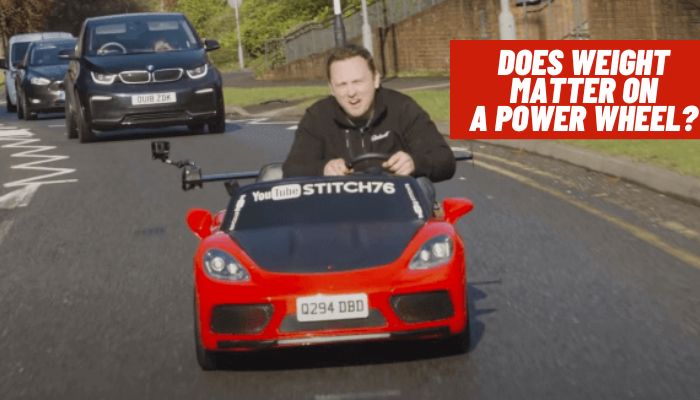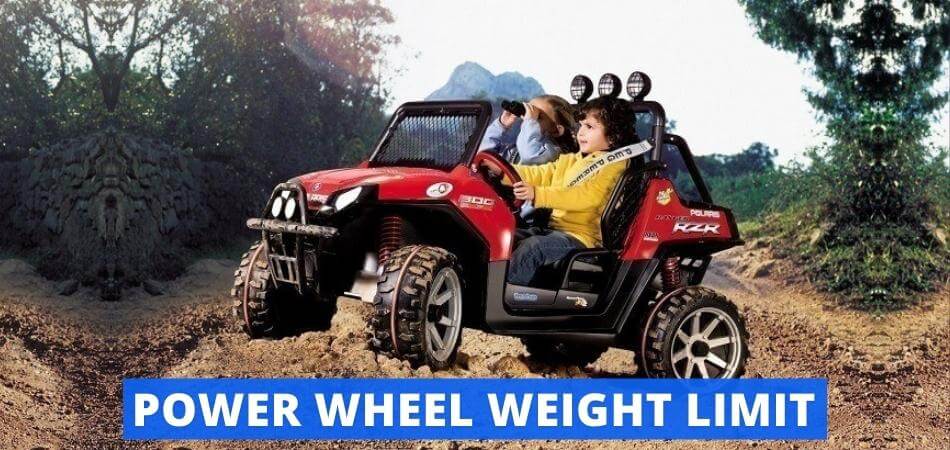Mark start research and blogging about five years ago beside his successful business about RC cars, ride-on toys, power wheels, etc. Although he is a...Read more
Power Wheel Weight Limit varies depending on several factors. One of such factors would be different weight limits for each age bracket of little children.
So, when you decide to purchase a cool ride for your kid, you should bear this important consideration in mind.
All cars have specific weight limits for efficiency and durability. Choosing the right car will enable your kids to enjoy the benefits for a longer time.
It is advisable to note that power wheel vehicles have unspecific load capacities.
Therefore, buying the right kind of Power Wheels weight limit is determined by the exact model type you like.
This article will walk you through the power wheel weight limit and the factors that affect how they function. Let’s ride on!
Does Weight Matter on A Power Wheel?
Weight plays a vital role in a power wheel since they follow some weight set rules. Usually, the weight limit of a power wheel depends on the manufacturer’s specification and the model of the toy car.

Here are some reasons the weight of ride-on-cars matters.
Create Fun for The Kid:
Kids are always excited to play in ride-on cars. So using the power wheel creates fun for them.
With the right power wheel that matches their weight, your kids will enjoy their toys. But where the kid’s weight exceeds that of the power wheel, the weight difference causes some challenges that are likely to cut off their fun time.
Ensures the Safety of the Kid:
Using the right weight limit for a power wheel ensures the proper functionality of the ride-on car.
So, you are sure that the safety of your kids is not compromised while using their toys. The right size for the child means that all the parts will work well without causing mishaps.
Limits the Traveling Speed of the Kid:
The moving speed will invariably change with excessive weight on a power wheel. In some cases, the car could start bending in the axel bar. This is the bar that connects the wheels both at the front and rear parts of the car. Hence, the speed will become quite slow. Where the pressure from the weight increases, the wheel nuts will likely break.
Power Wheel Weight Limit: Toys Weight Capacity
Typically, the Power Wheel Weight Limit depends on the model and manufacture of the power wheel in question.
It’s also essential to note that there are various weight categories, which are much related to the kids’ age.

Larger vehicles can support larger and older kids, whereas smaller vehicles typically support smaller and younger children. However, the average power wheel weight limit ranges between 18 KG (40 lbs.) to 59 KG (180 lbs.)
Let’s consider the following weight limits for each age group below.
12 Months – 24 Months
Toddlers under the age of 2 are still learning to walk and talk—some of the most basic things they’re learning. This is also an ideal time to introduce fun into their activities by bringing in Power Wheels to the party for them. Typically, Power Wheels for kids under 2 years old are created to be as lightweight, easy-to-control, and low as possible.
This age group requires a set of power wheels that can carry a load capacity of 40 lbs. (18 kg). Your younger toddlers can use them as often as they want.
Power Wheels for toddlers beneath 2 years old also come with in-built safety accessories that provide more convenience to your kids. These features include an easy-to-fix button and, sometimes, safety belts.
2 Years – 4 Years
Power Wheels for this age group come with an electric motor, remote control, and a 6V battery. This ride-on is specifically designed for kids between 2 to 4 years.
It comes with rubber wheels that provide more enhanced traction while riding on pavement and grass surfaces. Also, it’s built from durable plastic and has a maximum load capacity of 43 lbs. (19.5 kg).
Your kids can ride these power wheels for indoor and outdoor activities, suitable for all weather conditions.
This kind of ride-on incorporates three controls: child-driven, adult-driven, and adult-control driving modes. Additionally, it has a maximum speed of 6 MPH.
Also, it has a simple push-button situated on the car’s steering wheel. Thus, your kid can easily drive out of trouble.
Your kids get some level of independence while driving a vehicle in this age group.
However, adult supervision is still advised. Now, they can develop more eye-to-hand coordination, and most power wheels in this category come with several speed settings. This enables them to get used to their toys as fast or slow as they desire.
It’s worth noting that it is lower and close to the ground, and the rubber tires are non-slip. So, your kids can ride it without encountering many injuries from accidents while riding.
5 Years – 7 Years
Power Wheels in this age group have several deals to pick from. It most times resembles the 2-4 age group very much. However, there are some apparent distinctions in features and designs. It has a max weight capacity of 45kg (100 lbs.).
This category focuses majorly on the styles of the rides-on. Thus, power wheels in this category begin to resemble actual cars.
One amazing thing about power wheels in this category is that they are often great replicas of actual cars.
This can be challenging as the kid begins to use a real version and might crave things like go-karts and buggies. Noting that, it’s important to understand that your child is getting to 7 years old.
Some power wheels in this category come with features like 2 seats, a radio player, and a functional door set. It’s worthy to note that these vehicles can hit a top speed of 2.5 MPH as your child grows.
8 Years – 13 Years
As children grow, they appear to favor power wheels with faster speeds and greater power as an obvious result of aging.
Eventually, kids at 13 years can go for gas-powered rides like small ATVs or dirt bikes. Moreover, for children hoping for transitional vehicles, there are several options to pick from.
In this age group, the children tend to move from plastic rides-on to sporty vehicles, of which most of them are ATVs or go-carts.
This is because these offer users faster speeds than other options as they are composed of stronger materials like aluminum or steel.
However, you don’t need fancy features like disc brakes, active suspension, and gear transmission for smaller 8 year old kids.
14 Years and Older
Kids aged 14 years and older only fantasize about driving real cars, and vehicles in this category are the closest option to their desires.
Most power wheels designed for children in this category are go-karts and small cars that allow them to race with their friends.
They are the ones we consider as big kid power wheels. Power wheels in this age group are heavyweight and can support up to 160 lbs. (72.5kg) and provide greater power and speed.
There are tons of options to pick from for kids in this age group, as these vehicles can reach speeds of 12 MPH.
What Factors Affect How Much Weight Power Wheels Can Hold?

Noting that weight plays a major role in the functionality of your child’s power wheel, what then are the factors that determine how much weight it can carry?
Let’s look briefly into them below.
Age of the Child
The first and most important determiner of how much weight your power wheel can carry is the age and weight of your child. An average-sized 7-year-old can’t drive comfortably in a power wheel reserved for a 3-year-old.
This is because the child will invariably be overweight for the vehicle, and no one wants that. There are notable weight limits for power wheels that strongly rely on the child’s age and weight.
Terrain and Surface
The next thing to consider is the surface your child will be driving on. Some terrains will put more pressure on your child’s power wheel than others.
Also, some power wheels are not very effective on some surfaces and will struggle with your child’s weight on them. So, it’s best to note the terrain your child will be driving on.
For instance, if your child is driving off-road, on gravel, dunes, or hilly terrain, the weight should not be heavier than the wheels.
Can You Increase the Power Wheel Weight Limit?
It is possible to increase the power wheel’s weight limit and speed. You’d need to change two key components.
Upgrade the Motor Size
One essential way of increasing the weight limit of your Power wheel is to change the size of the motor. Get a motor with greater capacity and specifications.
Thus, you can take out that 12V motor and replace it using a more efficient 24V motor. This makes the ride more durable and capable of carrying heavier and older children.
Upgrade the battery
The next thing to consider replacing is the battery. Using a smaller 12V battery for a 24V motor will only drain the batteries quicker.
So, you must replace them with a stronger and more efficient battery capacity. Moreover, you may need some professional assistance to get on with that.
What Happens If I Exceed the Weight Limit on Power Wheels?
You might wonder if it’s possible to tell if you’ve exceeded the weight limit on your power wheels, and the answer is simple—yes.
When you exceed the weight limit on your power wheels, some things will occur. Let’s check out below.

Slower Speeds
This is the most notable sign of an overload on your power wheel. The vehicle will begin to run at a much slower speed, and you’d hear the motors audibly struggle to move forward.
If your child is driving a two-seater power wheel and the combined weight of both passengers weighs down on the power wheel, then you might need to get one down.
Abrupt Halting
The next sign of overweight on a power wheel is abrupt halting while riding. This usually occurs when the power wheel enters a change of terrain or surface gradient.
This sets off the thermal fuse.
For instance, if the car has a limit of 40 lbs. and the total weight carried is 40 lbs. on a flat surface, there are no issues.
But when the power wheel enters an inclined ground and moves up, the required torque to move up will supersede the 40 lbs. weight limit. This will be tripping off the 40 lbs. mark.
Shorter Run Time
Overweight on a power wheel will invariably put more weight on the motor and the battery. This will can shorten the span of the battery life.
So, while riding, it won’t last for as long as required. Therefore, you should take to heart the amount of load you’re putting on it.
The Power Wheel Doesn’t Move.
When this happens, it means that you’ve put more weight than the motors can carry. Therefore, the tires won’t move an inch.
Final Thoughts
Power Wheel Weight Limit depends on several factors and varies according to the child’s age, weight, terrain, and power wheel model.
It’s important not to overweigh your power wheel. However, if, by chance, you want to increase the weight limit, there are two valid solutions for you; change the battery and change the motors.

Mark start research and blogging about five years ago beside his successful business about RC cars, ride-on toys, power wheels, etc. Although he is a full-time businessman, he has a passion for research and blogging about the things he is good at. The “Toyscout24” is the result of that. He creates this site to assist people looking for RC cars and ride-on toys who don’t have proper knowledge about these toys.
More Posts